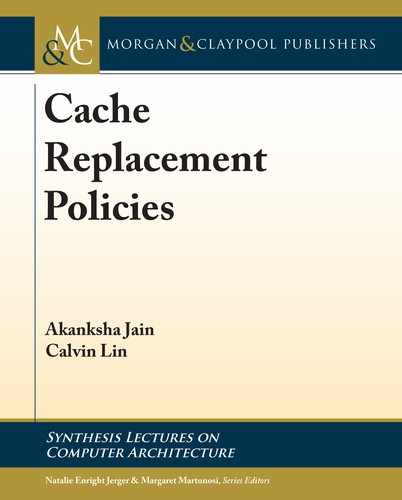
3.3. HYBRID POLICIES 21
Spectrum of LRFU according to the function F (x) = (½)
λx
,
where x is (current_time – reference_time).
Spectrum
(Recency/Frequency)
F (x) = 1 (LFU Extreme)
1
0
F (x)
F (x) = (½)
x
(LRU Extreme)
x
(current time - reference time)
Figure 3.9: e LRFU replacement policy; based on [Lee et al., 2001].
Table 3.11 summarizes the operation of LRFU policy for a block b at different decision
points.
Table 3.11: e least recently/frequently used (LRFU) policy
Insertion Promotion Aging Victim Selection
CRF (b) = F (0)
LAS T (b) = t
c
CRF (b) = F (0) +
F (t
c
– LAS T (b))
*
CRF
last
(b)
LAS T (b) = t
c
t
c
= t
c
+ 1
Line with min
CRF value
e performance of LRFU heavily depends on , so the subsequently developed ALRFU
policy dynamically adjusts the value of lambda [Lee et al., 1999].
3.3 HYBRID POLICIES
Hybrid policies [Jaleel et al., 2010b, Qureshi et al., 2006, 2007] recognize that different work-
loads, or even different phases within the same workload, benefit from different replacement
strategies. For example, if a program alternates between small and large working sets, it will
benefit from a recency-friendly policy when the working set it small and from a thrash-resistant
policy when the working set is large. us, hybrid policies assess the requirements of the appli-
cation’s current working set and dynamically choose from among multiple competing policies.
..................Content has been hidden....................
You can't read the all page of ebook, please click here login for view all page.
